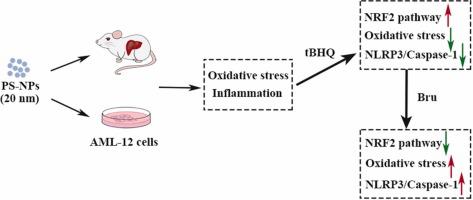当前位置:
X-MOL 学术
›
Ecotox. Environ. Saf.
›
论文详情
Our official English website, www.x-mol.net, welcomes your feedback! (Note: you will need to create a separate account there.)
Exposure to polystyrene nanoplastics induces hepatotoxicity involving NRF2-NLRP3 signaling pathway in mice
Ecotoxicology and Environmental Safety ( IF 6.8 ) Pub Date : 2024-05-09 , DOI: 10.1016/j.ecoenv.2024.116439 Yiqian Wen , Shiyi Deng , Binhui Wang , Fan Zhang , Tao Luo , Haibin Kuang , Xiaodong Kuang , Yangyang Yuan , Jian Huang , Dalei Zhang
Ecotoxicology and Environmental Safety ( IF 6.8 ) Pub Date : 2024-05-09 , DOI: 10.1016/j.ecoenv.2024.116439 Yiqian Wen , Shiyi Deng , Binhui Wang , Fan Zhang , Tao Luo , Haibin Kuang , Xiaodong Kuang , Yangyang Yuan , Jian Huang , Dalei Zhang

|
Nanoplastic contamination has been of intense concern by virtue of the potential threat to human and ecosystem health. Animal experiments have indicated that exposure to nanoplastics (NPs) can deposit in the liver and contribute to hepatic injury. To explore the mechanisms of hepatotoxicity induced by polystyrene-NPs (PS-NPs), mice and AML-12 hepatocytes were exposed to different dosages of 20 nm PS-NPs in this study. The results illustrated that and exposure to PS-NPs triggered excessive production of reactive oxygen species and repressed nuclear factor erythroid-derived 2-like 2 (NRF2) antioxidant pathway and its downstream antioxidase expression, thus leading to hepatic oxidative stress. Moreover, PS-NPs elevated the levels of NLRP3, IL-1β and caspase-1 expression, along with an activation of NF-κB, suggesting that PS-NPs induced hepatocellular inflammatory injury. Nevertheless, the activaton of NRF2 signaling by tert-butylhydroquinone mitigated PS-NPs-caused oxidative stress and inflammation, and inbihited NLRP3 and caspase-1 expression. Conversely, the rescuing effect of NRF2 signal activation was dramatically supressed by treatment with NRF2 inhibitor brusatol. In summary, our results demonstrated that NRF2-NLRP3 pathway is involved in PS-NPs-aroused hepatotoxicity, and the activation of NRF2 signaling can protect against PS-NPs-evoked liver injury. These results provide novel insights into the hepatotoxicity elicited by NPs exposure.
中文翻译:

暴露于聚苯乙烯纳米塑料会引起小鼠肝毒性,涉及 NRF2-NLRP3 信号通路
由于对人类和生态系统健康的潜在威胁,纳米塑料污染一直受到人们的强烈关注。动物实验表明,接触纳米塑料 (NP) 会沉积在肝脏中并导致肝损伤。为了探讨聚苯乙烯纳米粒子(PS-NPs)诱导肝毒性的机制,本研究将小鼠和AML-12肝细胞暴露于不同剂量的20nm PS-NPs。结果表明,接触PS-NPs会引发活性氧的过量产生,并抑制核因子红细胞衍生2样2(NRF2)抗氧化途径及其下游抗氧化酶的表达,从而导致肝脏氧化应激。此外,PS-NPs 升高了 NLRP3、IL-1β 和 caspase-1 的表达水平,同时激活 NF-κB,表明 PS-NPs 诱导肝细胞炎症损伤。然而,叔丁基氢醌激活 NRF2 信号传导可减轻 PS-NP 引起的氧化应激和炎症,并抑制 NLRP3 和 caspase-1 的表达。相反,NRF2 信号激活的拯救作用被 NRF2 抑制剂 brusatol 治疗显着抑制。总之,我们的结果表明,NRF2-NLRP3 通路参与 PS-NPs 引起的肝毒性,并且 NRF2 信号的激活可以防止 PS-NPs 引起的肝损伤。这些结果为纳米粒子暴露引起的肝毒性提供了新的见解。
更新日期:2024-05-09
中文翻译:

暴露于聚苯乙烯纳米塑料会引起小鼠肝毒性,涉及 NRF2-NLRP3 信号通路
由于对人类和生态系统健康的潜在威胁,纳米塑料污染一直受到人们的强烈关注。动物实验表明,接触纳米塑料 (NP) 会沉积在肝脏中并导致肝损伤。为了探讨聚苯乙烯纳米粒子(PS-NPs)诱导肝毒性的机制,本研究将小鼠和AML-12肝细胞暴露于不同剂量的20nm PS-NPs。结果表明,接触PS-NPs会引发活性氧的过量产生,并抑制核因子红细胞衍生2样2(NRF2)抗氧化途径及其下游抗氧化酶的表达,从而导致肝脏氧化应激。此外,PS-NPs 升高了 NLRP3、IL-1β 和 caspase-1 的表达水平,同时激活 NF-κB,表明 PS-NPs 诱导肝细胞炎症损伤。然而,叔丁基氢醌激活 NRF2 信号传导可减轻 PS-NP 引起的氧化应激和炎症,并抑制 NLRP3 和 caspase-1 的表达。相反,NRF2 信号激活的拯救作用被 NRF2 抑制剂 brusatol 治疗显着抑制。总之,我们的结果表明,NRF2-NLRP3 通路参与 PS-NPs 引起的肝毒性,并且 NRF2 信号的激活可以防止 PS-NPs 引起的肝损伤。这些结果为纳米粒子暴露引起的肝毒性提供了新的见解。






























 京公网安备 11010802027423号
京公网安备 11010802027423号